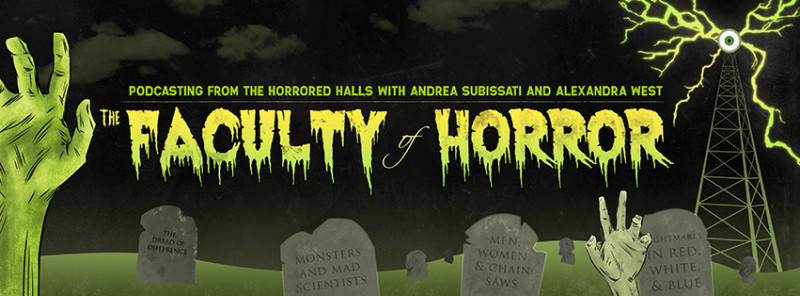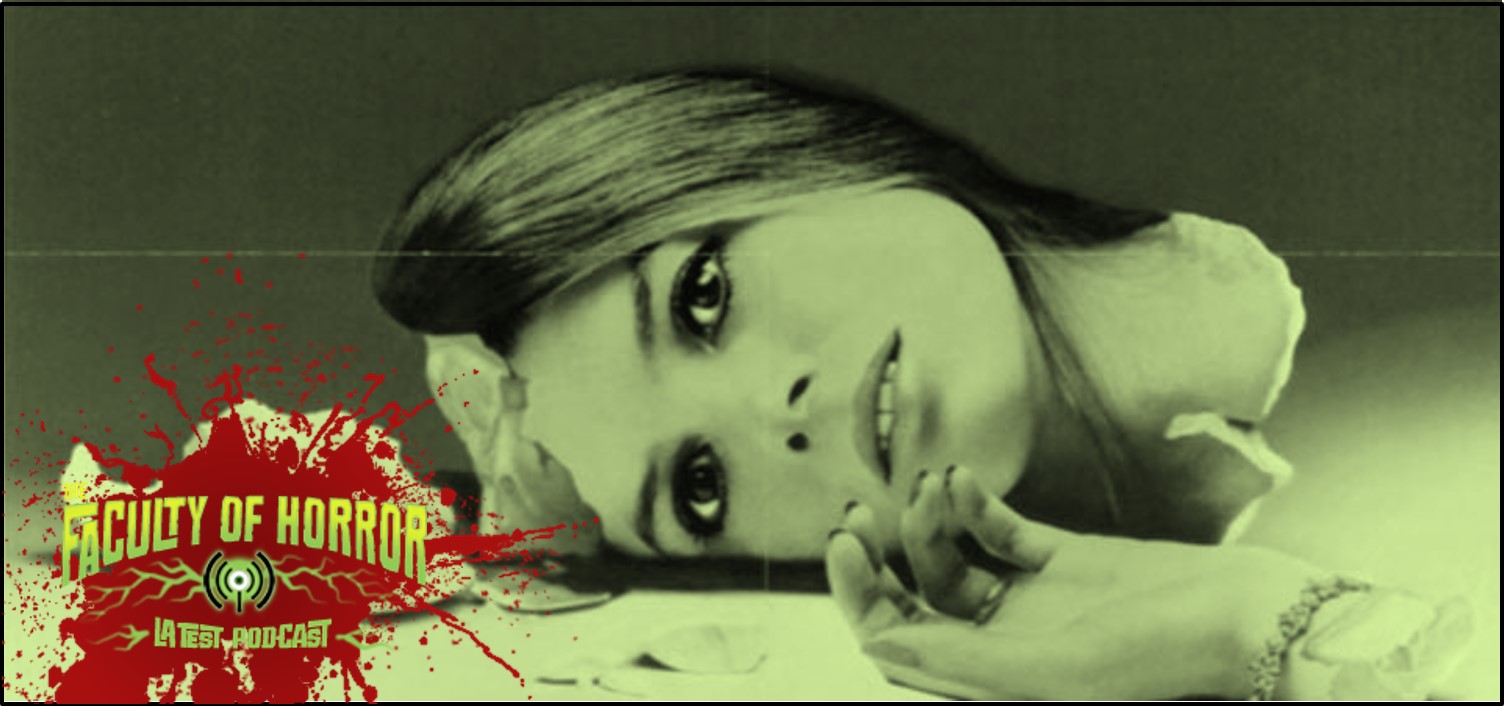This month, Andrea and Alex tackle two films whose hearts lie in the darkest, most secret parts of suburban utopia. In Bryan Forbes’ The Stepford Wives and Jordan Peele’s Get Out, we follow protagonists who are socialized to make room for the privileged and examine what happens when they strike back.
REQUIRED READING
The Stepford Wives. Dir Bryan Forbes, 1975.
Get Out. Dir Jordan Peele, 2017.
EXTRA CREDIT
The Feminine Mystique by Betty Friedan. The second-wave feminism manifesto that examines “the problem that has no name.”
The 21st century cult of domesticity. As relevant today as ever.
The Cyborg Mystique. Anna Krugovoy Silver’s examination of the opposing and overlapping views in The Feminine Mystique and The Stepford Wives.
How to Dress Like a Stepford Wife. Great fashion advice without a trace of irony.
On Photography by Susan Sontag. Sontag’s influential treatise on photography and its power.
Capitol Couture via ladyhellbat.com. In which Andrea gets her Hunger Games in a twist.
Horror Noire: Blacks in American Horror Films from the 1890s to Present by Robin R Means Coleman. A history and analysis of blackness in horror cinema.
HORROR BLACKADEMICS: THE GET OUT (2017) SYLLABUS. Graveyard Shift Sister’s compilation of essays about Get Out.
The Horror, The Horror: “Get Out” And The Place of Race in Scary Movies. NPR’s Code Switch’s episode on Get Out and race in horror.
Jordan Peele on Why Get Out Is an Important Movie. Oprah’s interview with Jordan Peele.
‘Horror Noire’ Author Robin R. Means Coleman: The Horror News Network WiHM Interview. An interview with Means Coleman about horror, her book and Get Out.
Surveilling the City: Whiteness, the Black Man and Democratic Totalitarianism. John Fiske’s examination of the normalization of Whiteness through surveillance.
Whitopia: My Trip Through the Whitest Towns in America. Rich Benjamin’s TED talk about his experience living in the fast-growing white communities in America.
Why Hollywood’s White Savior Obsession Is an Extension of Colonialism. An examination of the problematic trope embedded in numerous popular films.
The White-Savior Industrial Complex. How the White Savior trope is embedded in day-to-day life.
LISTEN
Right click or option-click here and choose “Save Target As…” to download the mp3.
Podcast: Play in new window | Download


It’s true that that is 3rd wave feminism, but if you can do whatever then what is the point of it 🙁
You two do the best f’ing podcast out there. I can hardly wait for them to come out. Your commentary on racism is so enlightening
I’ve been a longtime listener but never commented here; I just wanted to thank you for the “extra credit” links — it’s so helpful for those of us wanting to dig deeper into the material. I truly appreciate it!
Goddamn I love you ladies so much. This episode was brilliant, and the sound editing at the end b/w Alex’s voice –> “Do you bleed?” –> The Pixies was the icing on the cake. THANK YOU for making this podcast.
I rewatched “The Stepford Wives” a couple months ago, and what really stood out for me this time is the level of the conspiracy against Joanna (and Bobbie, Charmaine and the other women).
When Ted’s robot wife brings Walter and Joanna the casserole, Walter takes the pot back to and says, “she cooks as good as she looks, Ted.” That’s when I realized Walter knew what was going on in Stepford even before they moved there, and that making Joanna the “perfect housewife” is his dream.
Late in the film, Joanna says her replacement will cook and clean but it won’t take pictures “and it won’t be me.” Frankly, that’s what Walter wants. As an actual, equal human being, Joanna has wants, frustrations and ambitions outside of her role as wife and mother. But Walter and the other men don’t want to deal with their wives as people — they just want docile, smiling robots who will, yes, cook and clean, while also faking it (loudly, if not exactly convincingly) during sex.
I don’t know what’s more depressing — that Ira Levin and the director expected so little of their male characters, or that they were probably right, and that’s largely what men wanted back then.
I really enjoyed the episode. Very interesting discussion.
When I was lectured on Walter Benjamin back in college, my professor pronounced it “Ben-ya-min”. Anyone else want to weigh in?
As a professor I can state with certainty that you can’t trust everything we say – I had a sociology prof who pronounced our species as “HUMO SOPPEEANS” – I thought he had a speech impediment. I think the actual name “Benjamin” is English in derivation meaning “son of my right hand.” As such I suspect the “J” would be pronounced with the “je” rather than the “ye.” But, of course, I could be missing something 🙂
Wonderful episode as always. I think I also sent an email but not sure it got through. Anyway, Joanna going back for her children reminded me of John Coffee in THE GREEN MILE saying Wild Bill killed the girls with their love for each other (he said if one screamed he’d kill the other -ugh!). Anyway, love creates hostages to fate as well as murderers. Love as a type of “beast” in that sense is worthy of reflection. My partner and I have 2 kids and the world became a scarier place after their birth. Also resonates with new Haunting of Hill House on Netflix – hope you cover that in future
The Stepford Wives is part of a cycle of ’70s US horror based around older women (some of these women could even have been mothers to the final girls of the ’80s!)
The women in these upmarket horror films, which were aimed at a general middle class audience and not just horror fans, were not defined by their relationship to physical violence like the heroines of the slashers, but through their interactions with family and friends.
The cycle arguably begins in 1969 with Rosemary’s Baby (Mia Farrow) and includes:
1971 The Mephisto Waltz (Jacqueline Bisset)
1972 The Possession of Joel Delaney (Shirley MacLaine)
1973 The Exorcist (Ellen Burstyn)
1976 Burnt Offerings (Karen Black)
1977 Audrey Rose (Marsha Mason)
1977 Demon Seed (Julie Christie)
1977 Full Circle (Mia Farrow, again)
1977 The Sentinel (Cristina Raines)
1978 Coma (Geneviève Bujold)
1979 The Amityville Horror (the great Margot Kidder, who really deserves an episode of her own)
It should be noted that a number of these films were based on novels which centred around the possession narrative from a female perspective (Rosemary’s Baby, The Mephisto Waltz, The Possession Of Joel Delaney, The Exorcist and Audrey Rose).
I believe The Stepford Wives would really gain from being discussed in relation to this film cycle which gave a new prominence to women in US horror.
I hope you will cover some of the titles in the above list in future episodes.
I am a little embarrassed to admit that I have only recently discovered your podcast, but you are totally singing my tune! I love the movies, the feminist slant, and the literary/cultural criticism. I also love the links to further reading/listening. This particular episode is the gateway drug I plan to share with my friends. Thank you so much for doing the work, and doing it so thoroughly.
If you have already done so, I apologize (I am still working my way through your backlist) but I would love an episode that examines representations of middle-aged and older women in horror movies. I have seen a lot of mothers and hags, but not much else. In fact, as per Paul Dann’s comment above, female lead characters are generally getting younger – a lot of the roles he lists would probably be recast with younger actors in a present day remake.
The thing that struck me most about Stepford Wives when I saw it was that the production quality seemed more like a TV movie than the famous film I’d been led to expect.
“Emotional labor” was defined to be paid labor that involves managing the emotions of customers. So a mother taking care of her own kids wouldn’t qualify, but a daycare worker would.
Fraternal orders like the Freemasons or Shriners are known for doing community-oriented stuff. My impression is that they’ve declined a lot since the midcentury, so now their members tend to be elderly.
I thought Get Out deserved Best Director more than it did Best Original Screenplay. The review titled “Being John Malcolm X” is no longer on the internet, but it pointed out that the protagonist of the film in no way resembles Peele’s actual life and what his actions reveal his fears to be (or not be), but he correctly figured that this version would be more accessible than something Charlie Kaufman-esque, which Peele does seem capable of writing. You mentioned the more downer ending, and he correctly deduced that a happy ending would be more popular.
On post-racialism, I think the best take is Fabio Rojas on what he calls the “post-racism society”.
What is the evidence for the effectiveness of unconscious bias workshops?
I would distinguish between People Under the Stairs and Candyman. The former has a black protagonist, even if the director is white.